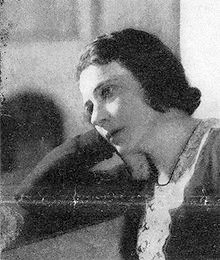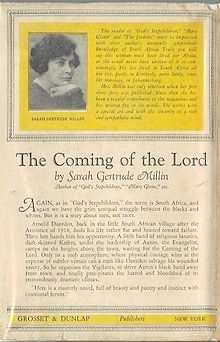Kimberley, South Africa


Sarah Millin
Sarah Gertrude Millin
1889 - 1968
Sarah Millin, before 193
Sarah Gertrude Millin was born on 19 March 1889 in Zagar, Lithuania. She was the eldest child and only daughter of Isaiah Liebson, a Jewish merchant, and his wife, Olga Friedmann. According to Sarah her birth was not registered and calculations indicate that she must have been born about March 1888. Her maternal grandfather had been a Kimberley pioneer and while visiting Europe persuaded Isaiah and Olga to join the Litvak immigration to South Africa during the 1880s.
The Liebsons, with their five-month-old daughter, arrived in Cape Town in August 1888 and went on to Beaconsfield, near the Kimberley diamond-fields, where Isaiah opened a trading store. In 1894 the family settled at Waldeck’s Plant, a section of the Vaal River alluvial diggings in the Barkly West district. Sarah’s father, never a good businessman, managed to make a fairly comfortable living among the European diggers, Black labourers, and Coloured people by exercising trading, water, and ferry rights and by running a small cattle farm that showed no profit.
Sarah and her six brothers, one who died at the age of three, appear to have been the only White children at Waldeck’s Plant, a circumstance of decisive influence on her later views regarding South Africa’s multi-racial society. She began to write poetry when she was six, taught herself German with her mother’s encouragement and the aid of a school primer, and developed the voracious reading habit that was to damage her eyesight permanently. She first attended school at Beaconsfield, staying with relatives there, and then continued in Kimberley, living in boarding houses until the outbreak of the Second Anglo-Boer War in 1899. From this period dates her life-long insomnia, the outcome of unfamiliar bedrooms, absence from her family, and fear of the dark.
At the end of the war Sarah became a pupil at the Kimberley High School for Girls, where she achieved a first-class Matriculation pass in 1904. Her marks were the highest for girls in the Cape Colony and brought her a special citation for distinction in mathematics. She also won the Victoria Memorial Exhibition, the University Bursary, and was awarded a Barnato Scholarship. Eyestrain and physical debilitation prevented her from pursuing a university education at the South African College, Cape Town. Instead, she studied music in Kimberley, receiving her teaching certificate in 1906. But she never taught, preferring to devote her talents to literature.
In her lifetime, she was one of the most popular English-language novelists in South Africa. She also wrote biographies of Cecil Rhodes and General Jan Smuts.
Her husband, Philip Millin, a judge of the Supreme Court of South Africa, died of heart failure on the bench while she had just begun to write her autobiography The Measure of My Days, an event which affected her deeply (Margaret Lane, reviewing the autobiography in the Sunday Times).
With an abrasive personality and domineering attitude, Sarah made enemies easily. Yet she could be most generous to those who gained her sympathy, especially to young, struggling authors. Her growing acceptance, in principle, of separate development for the Black and the White races in Africa alienated her from the liberal left and resulted in many adverse estimations of her work. In her historical writings she was largely impressionistic and lacked the necessary measure of scholarly objectivity; as a novelist she was the foremost writer of her generation. Her realistic portrayal of regional character and scene, notable for lucidity and precision of expression, remains of germinal importance to the development of South African English fiction.
Sadly Sara passed away on 06 July 1968 in Johannesburg aged 75.
SELECTED WORKS BY SARAH GERTRUDE MILLIN
The Dark River. London: 1919, New York: 1920; Middle Class. London: 1921; Adams’s Rest. London: 1922. New York: 1930; The Jordans. London: 1923, New York: 1923; God’s Step-children. London: 1924, New York: 1924; Mary Glenn. London: 1925, New York: 1925; The South Africans. London: 1926, New York: 1927. Revised and enlarged edition, London: 1934. Revised as The People of South Africa. London: 1951, Johannesburg: 1951, New York: 1954; An Artist in the Family. London: 1928, New York: 1928; The Coming of the Lord. New York: 1928, London: 1928; The Fiddler. London: 1929, New York: 1929.
Men on a Voyage. London: 1930; The Sons of Mrs. Aab. London: 1931, New York: 1931; Cecil Rhodes. New York and London: 1933. Republished as Rhodes. London: 1933. Revised ed. London: 1952, Cape Town: 1952; Three Men Die. New York: 1934, London: 1934; General Smuts. 2 Vols. London: 1936, Boston: 1936; What Hath a Man? New York and London: 1938; The Night is Long. London: 1941; The Herr Witchdoctor. London: 1941. Republished as The Dark Gods. New York and London: 1941; South Africa: The British Commonwealth in Pictures. London: 1941; War Diary. Six volumes. London: 1944–1948; King of the Bastards. New York: 1949, London: 1950; The Burning Man. London: 1952, New York: 1952; Measure of My Days. Johannesburg: 1955, London: 1955; New York: 1956; Two Bucks Without Hair: And Other Stories. Johannesburg: 1957, London: 1957; The Wizard Bird. London: 1962, Johannesburg: 1962; Goodbye, Dear England. London: 1965.
Bibliography
Bernstein, E. Memories of Sarah Gertrude Millin. New South African Writing. Cape Town: 1968; Braude, Claudia Bathsheba, ed. Contemporary Jewish Writing in South Africa, Lincoln and London: 2001; Braun, L. “Not Gobineau but Heine—not racial theory but biblical theme: the case of Sarah Gertrude Millin.” English Studies in Africa 34 (1) 1991: 27–38; Coetzee, J. M. “Blood, Taint, Flaw, Degeneration: The Novels of Sarah Gertrude Millin.” English Studies in Africa 23 (1) 1980: 41–48; Jaff, Fay. Women South Africa Remembers. Cape Town: 1975; Leveson, Marcia. People of the Book. Images of the Jew in South African English Fiction 1880–1992. Johannesburg: 2001; Rubin, Martin. Sarah Gertrude Millin: a South African life. Johannesburg: 1977; Snyman, J. P. L. The Works of Sarah Gertrude Millin. Johannesburg: 1955; Scanlon, Paul, ed. Dictionary of Literary Biography: 235 South African Writers. New York: 2000, 270–282.




